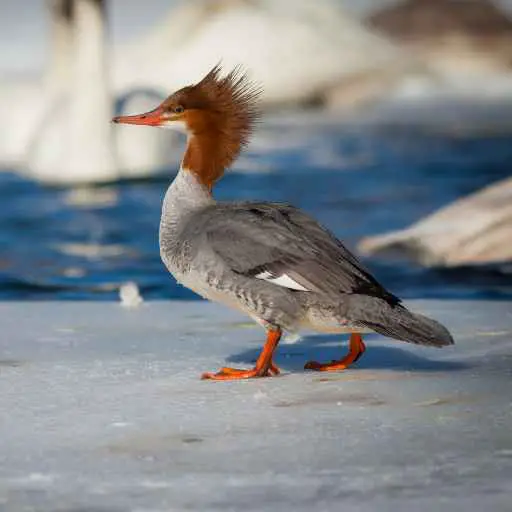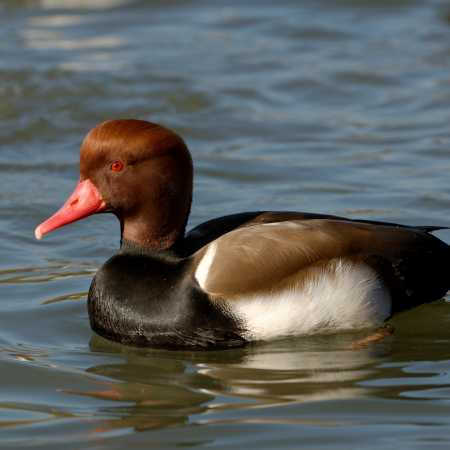Ducks are a common sight in ponds and lakes around the world. But have you ever come across a duck with a bright orange head? These striking birds are not only beautiful to look at but also fascinating to learn about.
In this blog post, we will delve into the world of ducks with orange heads and discover the secrets behind their unique appearance.
Common Merganser
Common Merganser

- Common merganser is a large diving duck with black and white plumage.
- They feed on fish, insects, crustaceans, and amphibians.
- Habitat loss, pollution, and climate change threaten their populations.
The common merganser, also known as the goosander, is a large diving duck widespread across North America, Europe, and Asia. With its striking black and white plumage and a slender, serrated, and red-colored bill, the merganser is a distinctive bird of freshwater habitats.
The adult male merganser is striking with a white neck, orange feet, black upper parts, and a darkish green head that looks like a black head from a distance, while the female boasts a rusty-brown and grey body. Both sexes are equipped with a thin, pointed, and serrated bill, which they deftly use to catch and grip fish. Summer males and juveniles look similar to female plumage.
Common mergansers primarily feed on fish, but they also consume insects, crustaceans, and amphibians. Like other diving ducks, they are strong divers and can stay underwater for up to a minute to catch their prey.
Breeding populations are found in northern regions of North America, Europe, and Asia. During the winter, it moves south to more temperate areas. Its vast range includes Canada, the United States, Europe, and Asia.
The common merganser is a freshwater bird commonly found in streams, rivers, lakes, and reservoirs. They prefer habitats with clear water, abundant fish, and plenty of vegetation for nesting.
Common mergansers are monogamous and nest in tree cavities near water, laying 6-17 eggs in a clutch. The female incubates the eggs for approximately 30 days, and the chicks leave the nest within 24 hours of hatching. The chicks can swim and dive almost immediately and feed themselves.
The common merganser has a large global population and is not currently considered a threatened species. However, habitat loss, pollution, and climate change pose significant threats to their populations. Oil spills, hydroelectric dams, and human disturbance during the breeding season can also impact their reproductive success. Conservation efforts such as habitat protection and pollution reduction are crucial to ensure the continued success of the common merganser.
Red-Crested Pochard
Red-Crested Pochard

- The red-crested pochard is a diving duck found in Europe, Asia, and North Africa.
- Males have a red head and breast with a white band around the bill, and a red bill with a black tip. Females have a brown head and body with a light-colored eye-ring and a white band around the bill.
- Red-crested pochards prefer shallow freshwater habitats and nest in shallow depressions on the ground.
The red-crested pochard (Netta rufina) is a medium-sized diving duck found in Europe, Asia, and North Africa. With its striking plumage and unique red crest, this bird is easily distinguishable from other duck species.
The male red-crested pochard has a dark red head, black breast, and a grayish-blue body with a white band around the base of the bill. The most distinguishing feature of this bird is its bright red bill with a black tip. The female Red-crested pochard has a brown head and body, with a light-colored eye-ring and a similar white band around the base of the bill.
Red-crested pochards are gregarious birds that often form large flocks, feeding on various aquatic plants, insects, and small fish in mixed flocks. They will also consume small invertebrates, mollusks, and crustaceans.
The red-crested pochard breeds range from Central and Eastern Europe to Western and Central Asia, including parts of the Middle East and North Africa. During the winter, these diving ducks can be found in southern Europe and Asia. Red-crested pochards prefer shallow freshwater habitats, such as ponds, lakes, and slow-moving rivers, with plenty of vegetation and cover.
Red-crested pochards nest in shallow depressions on the ground, lined with vegetation and down feathers. The female lays an average of 8-10 eggs, which are incubated for around 25-28 days. The young can leave the nest shortly after hatching and swim and forage for themselves, although they may remain with their parents for several weeks.
Key Takeaways
- The female common merganser has an orange to cinnamon-colored head.
- The red-crested pochard has a warm reddish head.
- Both species prefer shallow freshwater habitats and migrate in winter.
- Like most birds, these ducks face threats from habitat loss, hunting, and trapping and need conservation efforts for protection.
Related Questions on Ducks
Duck Scientific Names
American Wigeon Scientific Name: Mareca americana
Blue-Winged Teal Scientific Name:
Canvasback Scientific Name: Aythya valisineria
Common Goldeneye Scientific Name: Bucephala clangula
Harlequin Duck Scientific Name: Histrionicus histrionicus
Mallard Scientific Name: Anas platyrhynchos
Mandarin Duck Scientific Name: Aix galericulata
Northern Pintail Scientific Name: Anas acuta
Northern Shoveler Scientific Name: Spatula clypeata
Ring-Necked Duck Scientific Name: Aythya collaris
Ruddy Duck Scientific Name: Oxyura jamaicensis
Wood Duck Scientific Name: Aix sponsa
What ducks have a dark head?
Many species of ducks have a dark head, but some of the most well-known ones include the the American Black Duck, the Gadwall, and the Northern Pintail. Note that these ducks don’t necessary have black heads but their heads are darker than most ducks.
What is the color of the gadwall’s body?
Gadwalls have a gray body.
What ducks have a reddish brown head?
Both male and female Eurasian Wigeons have a distinctive reddish-brown to orange-brown head. The male’s head is a brighter reddish-brown with a creamy yellow forehead and a white belly, while the female’s head is a more subdued reddish-brown with a creamy buff forehead and a grayish-brown breast.
How does a dabbling duck eat?
Dabbling ducks are special ducks that feed by tipping their heads down into the water and sticking their bums up in the air. They use their bills to search for tasty things, like plants and small animals. They don’t dive all the way underwater as some other ducks do, but instead just get their beaks wet.
What female ducks have mottled brown bodies?
Females ducks with mottled brown bodies include green-winged teal, cinnamon teal, northern shoveler, mallard and king eider.
Do long tailed ducks have long tail feathers?
Yes, the long-tailed duck has long tail feathers. In fact, they are named after their long, pointed tails that can extend up to 5 inches (13 cm) beyond the rest of their body. These feathers are also very important for breeding males during courtship displays and for communication with other members of their species. Winter females and males have a white head.
What duck is considered a perching duck?
Wood ducks are the only ducks classified as perching ducks.
Where do Muscovy ducks come from?
Muscovy ducks are native to Central and South America.
What ducks have a black bill?
Ducks with black bills include canvasback, common goldeneye, Barrow’s goldeneye, surf scoter, cinnamon teal and northern shoveler.
What are sea ducks?
Sea ducks are a group of ducks that live in the ocean instead of on land or in fresh water. They have special adaptations that help them swim and dive in the rough waters of the sea. Some examples of sea ducks include eiders, scoters, and mergansers.
What ducks have a chestnut head?
Ducks with chestnut heads include canvasback and green-winged teal.
What ducks have a yellow bill?
Ducks with yellow bills include Barrow’s goldeneye and American black duck.
What ducks have a white ring?
Ducks with white rings include ring-necked duck and redhead. Both have gray sides and a gray bill.
What ducks have a white chest?
Ducks with white chests include common goldeneye and northern pintail.
What ducks have a white breast?
Ducks with white breasts include northern pintail, northern shoveler, and hooded merganser

